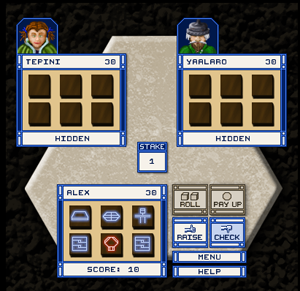Tepiiku is a simple but unusual dice game for exactly three players. At one time, I was intending to release a series of games, physical and digital, supposedly invented by an imaginary race of cavern-dwelling game-lovers called the Daumakku. My card game Insidious Sevens ended up being the only other one in the series.
As such, Tepiiku has the same visual theme as Insidious Sevens, and similarly cutthroat play. It combines the escalating stakes of a gambling game like no-limit poker with the push-your-luck element of dice games like Nada and Sid Sackson’s Can’t Stop to create maximum tension.
Rules
Tepiiku is a traditional Daumakku gambling game, using a special set of dice inscribed with the runes of the Deepfathers. Tepiiku means “triangle” in the Daumakku tongue, and as that name suggests, the game is always played with exactly three players.
The object of the game is to have the highest score showing at the end of the round, or at least not to have the lowest, as the player with the lowest score, known as the “Fish,” must pay a certain amount of money to the player with the highest score (the “Hook”).
The Fish always has the option of rerolling dice, however, in order to improve his or her score. The catch is that failing to improve one’s score means losing twice as much money as surrendering, so sometimes it is best just to give up.
Like regular dice, Tepiiku dice are six sided, featuring the following runes:
- Ingot: 1 pt.
- Gem: 2 pts.
- Fire: 3 pts., but worth 0 if any Water is showing.
- Water: 4 pts., but worth 0 if any Fire is showing.
- Skull: -2 pts.
- Person: Worth points equal to the number of People showing.
Each round of Tepiiku is played in three phases.
Rolling & Betting
Each player secretly rolls his or her three dice. Then, all three players simultaneously show “thumbs-up” or “thumbs-down,” indicating whether they’d like to play for a bigger pot or not. The starting pot is 1 coin, plus 1 for every “thumbs-up” shown.
Tie Resolution
Now, the dice are revealed. If any players have the same score, they must each simultaneously reroll one or more dice. This is repeated until there are no ties.
The Fish’s Choice
Now, whichever player has the lowest score is the Fish. The Fish must choose either to pay the Hook the current value of the pot, which ends the round, or to reroll. The Fish may reroll one, several, or even all his or her dice. There are several possible outcomes to rerolling:
- Bust!: If the Fish’s score stays the same or gets worse, he or she is bust, and must pay the Hook double the current value of the pot. This ends the round.
- Still the Fish: If the Fish’s score improves but fails to beat or tie the middle player’s score, the pot increases by one and the Fish has the same choice again, between paying up or rerolling.
- Tie: If the Fish’s score improves to exactly tie one of the other players’, the stakes double, and the other player must reroll one or more dice (but does not automatically Bust if their score gets worse). Repeated ties are handled the same way, with the stakes doubling each time, and the player who wasn’t the one rolling now forced to reroll. Once all ties have been resolved, whoever now has the lowest score is the new Fish and the round continues.
- Beating another Player: If the Fish’s score improves sufficiently to beat one or both of the other players, the player formerly in the middle is now the Fish. The stakes double, and the round continues.
The game ends when one player is out of money. Whichever of the remaining players has more, wins!
